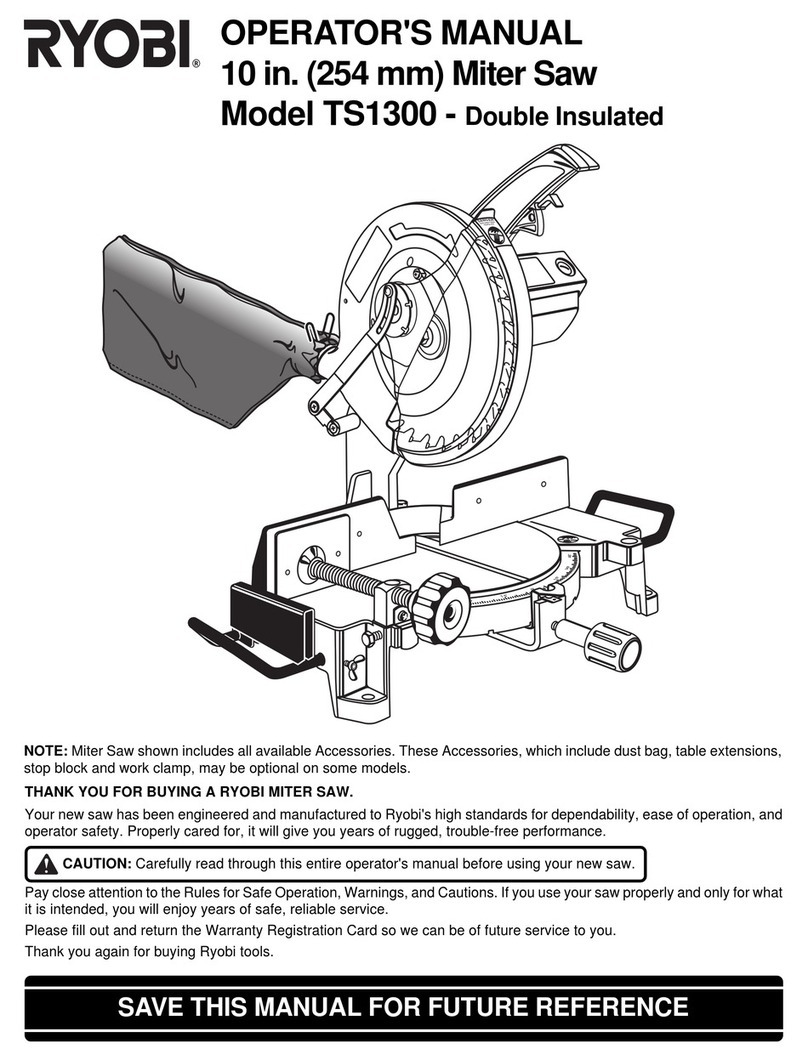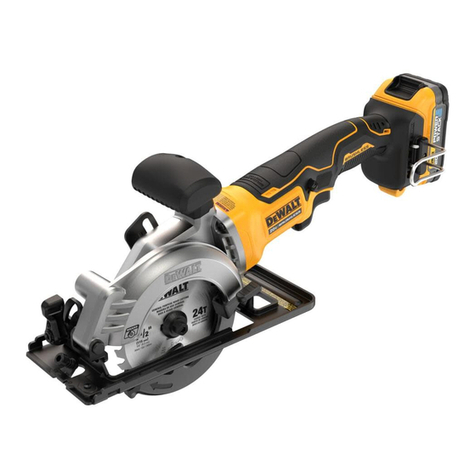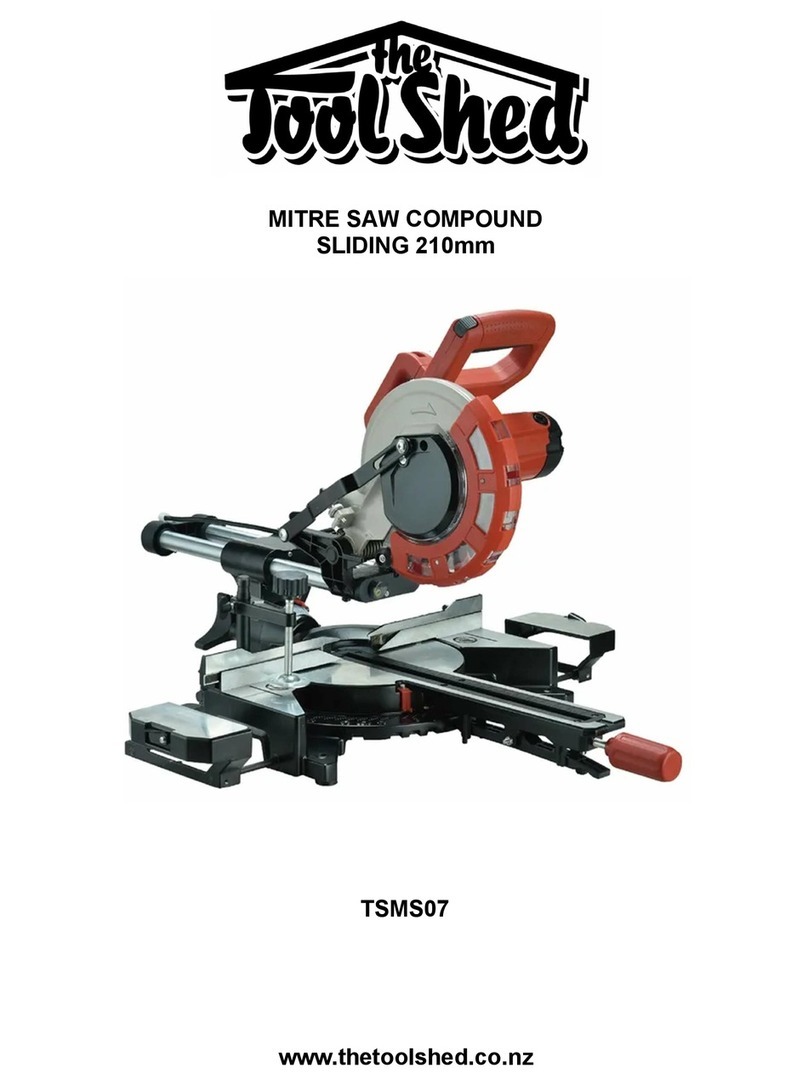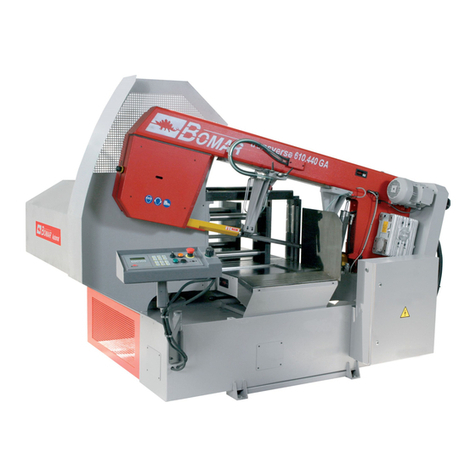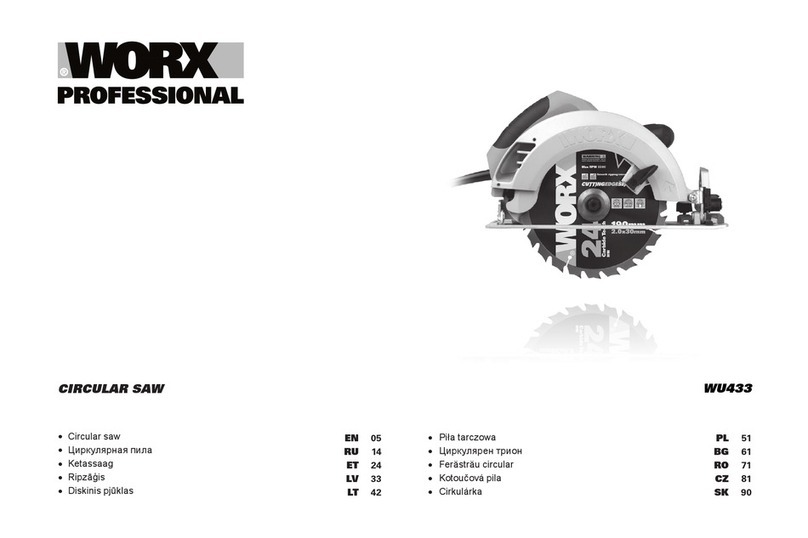Skil Master 3100 User manual

SKIL Europe BV - Konijnenberg 60 12/08 2610399062
4825 BD Breda - The Netherlands
COMPOUND MITRE SAW
3100 (F0153100..)
www.skileurope.com
www.skilmasters.com
ORIGINAL INSTRUCTIONS. . . . . . . . . . . . 13
NOTICE ORIGINALE . . . . . . . . . . . . . . . . . 17
ORIGINALBETRIEBSANLEITUNG . . . . . . 22
ORIGINELE GEBRUIKSAANWIJZING. . . . 28
BRUKSANVISNING I ORIGINAL . . . . . . . . 33
ORIGINAL BRUGSANVISNING . . . . . . . . . 38
ORIGINAL DRIFTSINSTRUKS. . . . . . . . . . 42
ALKUPERÄISET OHJEET . . . . . . . . . . . . . 47
MANUAL ORIGINAL . . . . . . . . . . . . . . . . . 52
MANUAL ORIGINAL. . . . . . . . . . . . . . . . . . 57
ISTRUZIONI ORIGINALI . . . . . . . . . . . . . . 62
EREDETI HASZNÁLATI UTASÍTÁS. . . . . . 68
PÒVODNÍM NÁVODEM K POUÎÍVÁNÍ . . . 73
OR‹J‹NAL ‹fiLETME TAL‹MATI . . . . . . . . . 78
INSTRUKCJÑ ORYGINALNÑ. . . . . . . . . . . 82
ОРИГИНАЛНЬОЕ РУКОВОДСТВО
ПО ЭКСПЛУАТАЦИИ . . . . . . . . . . . . . . . . 88
ОРИГІНАЛЬНА ІНСТРУКЦІЯ
З ЕКСПЛУАТАЦІЇ . . . . . . . . . . . . . . . . . . . 94
ΠΡΩΤΟΤΥΠΟ Ο∆ΗΓΙΩΝ ΧΡΗΣΗΣ . . . . . . 99
INSTRUCØIUNI DE FOLOSIRE
ORIGINALE . . . . . . . . . . . . . . . . . . . . . . . 106
ОРИГИНАЛНО РЪКОВОДСТВО
ЗА ЕКСПЛОАТАЦИЯ . . . . . . . . . . . . . . . 111
PÔVODN¯ NÁVOD NA POUÎITIE . . . . . 117
ORIGINALNE UPUTE ZA RAD . . . . . . . . 122
ORIGINALNO UPUTSTVO ZA RAD . . . . 127
IZVIRNA NAVODILA . . . . . . . . . . . . . . . . 131
ALGUPÄRANE KASUTUSJUHEND . . . . 136
ORI˛INÅLÅ LIETO·ANAS PAMÅC±BA. . 141
ORIGINALI INSTRUKCIJA. . . . . . . . . . . . 146
GB
F
D
NL
S
DK
N
FIN
E
P
I
H
CZ
TR
PL
ME77
RU
UA
GR
RO
BG
SK
HR
SRB
SLO
EST
LV
LT

2
13100
2
13,4 kg
EPTA 01/2003
5500 /min RUBBER
254 mm
MAX.
30 mm
250 mm
MIN.
30 mm
Watt
1800
3
MAX mm 0°
0°
135
70
MAX mm
45°
0°
70
90
MAX mm
45°
0°
135
40
MAX mm
45°
45°
40
90
2,0 - 3,2 mm

3
Q
T
C
R
X
A
B
C
E
F
H
G
G
G
L
L
K
K
N
S
T
WD
V
M
PZ
S1
4

4
B
90°
5
E
F
6
G
G
G
7

5
H
8
L
K
9
M2
M1
N
M4M3
M
0

6
B
B
B
B
A
A
A
A
Max A x Max B
70 x 135 mm
40 x 135 mm
70 x 90 mm
40 x 90 mm
0°
0°
0°
0°
0°
0°
45°
45° 45°
45°
45°
45°
45°
!

7
E
F
0°
45° 45°
P
@
0°
45°
Q
R
#

8
0°
45°
0°
45° 45° +
$
C
LASS 2 LASE
R
LASER RADIA
TION
A
A
DO NOT ST
ARE
INT
T
T
O
BEA
M
CLASS 2 LASER PRODUCT
P
m
a
x < 1m
W
,
ª
650
IEC/EN 60825-1: 2007
ªª
=650
nm
=650nm
S
2
S1
%

9
T
A
C
^

10
V2
V1V
W
X
V4
V3
V
&
*

11
Q
R1
(
Q
R
R2
)

12
N1
N
¡
P1
P
™
R3
R
£
≤ ∞

13
GB
Compound mitre saw 3100
INTRODUCTION
• This tool is intended as a stationary machine for
lengthways and crossways cutting of wood with straight
cuts as well as angle cuts (horizontal mitre angles of
-45° to +45° as well as vertical bevel angles of 0° to 45°
are possible)
• Read and save this instruction manual 2
TECHNICAL SPECIFICATIONS 1
TOOL ELEMENTS 4
ASwitch handle
BLocking pin for transport
CSafety lever
DTransport handle
ELocking handle (mitre angles)
FLocking clamp (mitre angles)
GMounting holes
HDust bag
KExtension bars
LKnobs for mounting extension bars
MClamp for mounting workpiece
NFence
PMitre angle indicator
QLocking knob (bevel angles)
RBevel angle indicator
SLaser light opening
S1 On/off switch laser
TOn/off switch
VBlade wrench
WProtective guard
XSpindle-lock button
ZTable insert
SAFETY
GENERAL SAFETY INSTRUCTIONS
WARNING! Read all safety warnings and all
instructions. Failure to follow the warnings and
instructions may result in electric shock, fire and/or serious
injury. Save all warnings and instructions for future
reference. The term “power tool” in the warnings refers to
your mains-operated (corded) power tool or battery-
operated (cordless) power tool.
1) WORK AREA SAFETY
a) Keep work area clean and well lit.
Cluttered or dark areas invite accidents.
b) Do not operate power tools in explosive
atmospheres, such as in the presence of flammable
liquids, gases or dust. Power tools create sparks
which may ignite the dust or fumes.
c) Keep children and bystanders away while operating
a power tool. Distractions can cause you to lose
control.
2) ELECTRICAL SAFETY
a) Power tool plugs must match the outlet.
Never modify the plug in any way. Do not use any
adapter plugs with earthed (grounded) power tools.
Unmodified plugs and matching outlets will reduce risk
of electric shock.
b) Avoid body contact with earthed or grounded
surfaces such as pipes, radiators, ranges and
refrigerators. There is an increased risk of electric
shock if your body is earthed or grounded.
c) Do not expose power tools to rain or wet conditions.
Water entering a power tool will increase the risk of
electric shock.
d) Do not abuse the cord. Never use the cord for
carrying, pulling or unplugging the power tool.
Keep cord away from heat, oil, sharp edges or
moving parts. Damaged or entangled cords increase
the risk of electric shock.
e) When operating a power tool outdoors,
use an extension cord suitable for outdoor use.
Use of a cord suitable for outdoor use reduces the risk
of electric shock.
f) If operating a power tool in a damp location is
unavoidable, use an earth leakage circuit breaker.
Use of an earth leakage circuit breaker reduces the risk
of electric shock.
3) PERSONAL SAFETY
a) Stay alert, watch what you are doing and use
common sense when operating a power tool.
Do not use a power tool while you are tired or
under the influence of drugs, alcohol or medication.
A moment of inattention while operating power tools
may result in serious personal injury.
b) Use personal protective equipment. Always wear
eye protection. Protective equipment such as dust
mask, non-skid safety shoes, hard hat, or hearing
protection used for appropriate conditions will reduce
personal injuries.
c) Prevent unintentional starting. Ensure the switch is
in the off-position before connecting to power
source and/or battery pack, picking up or carrying
the tool. Carrying power tools with your finger on the
switch or energising power tools that have the switch
on invites accidents.
d) Remove any adjusting key or wrench before turning
the power tool on. A wrench or a key left attached to a
rotating part of the power tool may result in personal
injury.
e) Do not overreach. Keep proper footing and balance
at all times. This enables better control of the power
tool in unexpected situations.
f) Dress properly. Do not wear loose clothing or
jewellery. Keep your hair, clothing and gloves away
from moving parts. Loose clothes, jewellery or long
hair can be caught in moving parts.
g) If devices are provided for the connection of dust
extraction and collection facilities, ensure these are
connected and properly used. Use of dust collection
can reduce dust-related hazards.

14
4) POWER TOOL USE AND CARE
a) Do not force the power tool. Use the correct power
tool for your application. The correct power tool will
do the job better and safer at the rate for which it was
designed.
b) Do not use the power tool if the switch does not turn
it on and off. Any power tool that cannot be controlled
with the switch is dangerous and must be repaired.
c) Disconnect the plug from the power source and/or
the battery pack from the power tool before making
any adjustments, changing accessories, or storing
power tools. Such preventive safety measures reduce
the risk of starting the power tool accidentally.
d) Store idle power tools out of the reach of children
and do not allow persons unfamiliar with the power
tool or these instructions to operate the power tool.
Power tools are dangerous in the hands of untrained
users.
e) Maintain power tools. Check for misalignment or
binding of moving parts, breakage of parts and any
other condition that may affect the power tool’s
operation. If damaged, have the power tool repaired
before use. Many accidents are caused by poorly
maintained power tools.
f) Keep cutting tools sharp and clean.
Properly maintained cutting tools with sharp cutting
edges are less likely to bind and are easier to control.
g) Use the power tool, accessories and tool bits etc.,
in accordance with these instructions, taking into
account the working conditions and the work to be
performed. Use of the power tool for operations
different from those intended could result in a
hazardous situation.
5) SERVICE
a) Have your power tool serviced by a qualified repair
person using only identical replacement parts.
This will ensure that the safety of the power tool is
maintained.
SPECIFIC SAFETY INSTRUCTIONS FOR COMPOUND
MITRE SAWS
GENERAL
• Only use the tool for cutting wood
• Always saw a single workpiece (workpieces placed
one on the other or next to each other cannot be
properly clamped which may result in saw blade binding
or workpiece slipping during sawing)
• Inrush currents cause short-time voltage drops; under
unfavourable power supply conditions, other equipment
may be affected (if the system impedance of the power
supply is lower than 0,295 + j0,184 Ohm, disturbances
are unlikely to occur); if you need further clarification,
you may contact your local power supply authority
• Always disconnect plug from power source before
making any adjustment or changing any accessory
• This tool should not be used by people under the age of
16 years
• This tool is not suitable for wet cutting
OUTDOOR USE
• When used outdoors, connect the tool via a fault current
(FI) circuit breaker with a triggering current of 30 mA
maximum, and only use an extension cord which is
intended for outdoor use and equipped with a
splashproof coupling-socket
BEFORE USE
• Always check that the supply voltage is the same as the
voltage indicated on the nameplate of the tool (tools
with a rating of 230V or 240V can also be connected to
a 220V supply)
• Use completely unrolled and safe extension cords with
a capacity of 16 Amps (U.K. 13 Amps)
• Always mount the tool on a flat and stable working
surface (e.g. workbench)
• Wear protective glasses, hearing protection, and
protective gloves
• Dust from material such as paint containing lead, some
wood species, minerals and metal may be harmful
(contact with or inhalation of the dust may cause
allergic reactions and/or respiratory diseases to the
operator or bystanders); wear a dust mask and work
with a dust extraction device when connectable
• Certain kinds of dust are classified as carcinogenic
(such as oak and beech dust) especially in conjunction
with additives for wood conditioning; wear a dust
mask and work with a dust extraction device when
connectable
• Follow the dust-related national requirements for the
materials you want to work with
• Do not work materials containing asbestos (asbestos
is considered carcinogenic)
• Never use the tool without the original protection guard
system
• Check the protective guard for proper closing before
each use
• Do not operate the saw if the protective guard does not
move freely and close instantly
• Never clamp or tie the protective guard into the open
position
• Always firmly clamp the workpiece (do not work
with pieces that are too small to clamp)
• Always support the free ends of a long workpiece
• Never allow another person to hold or support the
workpiece while working; use the saw table extension
• Never use the tool without the table insert; replace a
defective or worn table insert
• Remove all obstacles on top of as well as underneath
the cutting path before you start cutting
• Avoid damage that can be caused by screws, nails and
other elements in your workpiece; remove them before
you start working
ACCESSORIES
• Never use grinding/cutting discs with this tool
• SKIL can assure flawless functioning of the tool only
when the correct accessories are used which can be
obtained from your SKIL dealer
• For mounting/using non-SKIL accessories observe the
instructions of the manufacturer concerned
• Use only accessories with an allowable speed matching
at least the highest no-load speed of the tool

15
• Never use saw blades made of high speed steel (HSS)
• Do not use a saw blade which is cracked, deformed or
dull
• Only use saw blades with a hole diameter which fits the
tool spindle without play; never use reducors or
adaptors to fit large-hole saw blades
• Protect accessories from impact, shock and grease
DURING USE
• Do not force the tool; apply light and continuous
pressure
• Keep fingers, hands and arms away from the
rotating saw blade
• Push spindle-lock button only when tool is at a
standstill
• When slotting, ensure that the saw blade does not get
jammed in the workpiece
• If the saw blade becomes blocked, switch off the tool
immediately and disconnect the plug; only then remove
the wedged workpiece
• In case of jamming or electrical or mechanical
malfunction, immediately switch off the tool and
disconnect the plug
• If the cord is damaged or cut through while working, do
not touch the cord, but immediately disconnect the plug
• Never use the tool when cord is damaged; have it
replaced by a qualified person
LASER RADIATION
• Do not look into the laser beam (laser radiation) 3
• Do not point the laser beam at persons or animals
• Do not use any magnifying optical tools (such as
magnifying glasses, telescopes, or binoculars) to view
the laser beam
• Do not operate the tool in the presence of flammable
liquids, gases or dust
• Do not operate the tool with children around
AFTER USE
• After switching off the tool, never stop the rotation of
the accessory by a lateral force applied against it
• Only remove cut-offs or other parts of the workpiece
from the cutting area when all moving parts have come
to a complete standstill
• The saw blade becomes very hot during use; do not
touch it before it has cooled down
WHEN CONNECTING NEW 3-PIN PLUG (U.K. ONLY):
• Do not connect the blue (= neutral) or brown (= live) wire
in the cord of this tool to the earth terminal of the plug
• If for any reason the old plug is cut off the cord of this
tool, it must be disposed of safely and not left
unattended
USE
• Transport/working position 5
For releasing the tool (working position)
- press handle A 4downward with one hand to
prevent tool arm from swinging upward unexpectedly
- pull out locking pin B 4with the other hand, rotate it
1/4 turn in either direction and release it in that
position
- guide the tool arm slowly upward
For securing the tool (transport position)
- press safety lever C 4while lowering the tool arm
with handle A to the stop
- release safety lever C and press handle A downward
with one hand to prevent tool arm from swinging
upward unexpectedly
- pull out locking pin B 4with the other hand, rotate it
1/4 turn in either direction and release it in that
position
- use transport handle D for carrying the tool
• Mounting locking handle for mitre angles 6
- screw locking handle E into the hole beneath locking
clamp F
! do not tighten the handle too firmly
• Mounting tool on working surface 7
! for safe handling always mount tool on a flat and
stable working surface (e.g. workbench)
- use 4 mounting holes G for attaching the tool with
suitable screws to the working surface
- you may also clamp the tool to the working surface
with commercially available screw clamps
• Dust/chip extraction 8
- mount dustbag H as illustrated
- empty dustbag regularly for optimal dust pick-up
performance
! never let the vacuum cleaner hose interfere with
the lower guard or the cutting operation
• Saw table extension 9
- use knobs L to fasten extension bars K (on either
side of the tool)
• Clamping the workpiece 0
! for optimum working safety always firmly clamp
the workpiece with the adjustable clamp supplied
- assemble clamp M as illustrated
- fasten assembled clamp into support hole M1 with
knob M2 (on either side of the tool)
- press the workpiece firmly against fence N
- adapt clamp to the workpiece with knob M3
- firmly clamp the workpiece by turning down knob M4
- do not work with workpieces that are too small to
clamp
! for maximum workpiece dimensions use table !
as reference
• Setting mitre angles @
- loosen locking handle E
- push down clamp F, rotate the saw table to the left or
right and set the desired mitre angle (from 0° to 45°)
by using indicator P
- release clamp F and tighten locking handle E
- for quick and precise setting of often used mitre
angles (0°, 15°, 22.5°, 31.6°, 45°) use the
corresponding indentations underneath the saw table
(ensure that clamp F engages in the desired
indentation)
• Setting bevel angles #
- loosen three-legged knob Q
- swing the tool arm to the left until bevel angle
indicator R points to the desired bevel angle
- hold the tool arm in this position and tighten knob Q

16
• Compound cuts $
- compound cuts require both a mitre angle setting
and a bevel angle setting
! always test out first on a piece of scrap material
• Laser line %
- for guiding tool along desired line of cut marked on
the workpiece
- switch on/off laser line by pressing switch S1
- before starting a job, check the alignment of the laser
line with the actual line of cut by making a trial cut on
a piece of waste material
! do not remove or damage warning label S2
• Operating the tool ^
- set tool into working position
! ensure that the workpiece is firmly clamped
against the saw table and fence N 4
! ensure that the saw blade will not come in
contact with fence N 4, clamp M 4or possible
interfering auxiliary stops
! cutting width is determined by width of blade
teeth and not by width of blade body
- connect plug to power source
- switch on the tool by pulling switch T into handle A
! switch T cannot be locked, so keep it depressed
during operation
- press safety lever C simultaneously for guiding the
tool arm downward
! do not cross your arms when operating the tool
arm
- saw through the workpiece with uniform advancing
! keep fingers, hands and arms away from the
rotating saw blade
! the tool should run at full speed before the blade
enters into the workpiece
- switch off the tool by releasing switch T
• Changing saw blade &
! disconnect the plug
- take blade wrench V from storage by loosening
screw V1
- remove cover plate screw V2 (including washer) by
using a Phillips screwdriver
- press safety lever C 4and rotate protective guard W
completely backwards
- push spindle-lock button X and hold it while you
remove blade bolt V3 by turning blade wrench V
CLOCKWISE (= in same direction as arrow printed on
saw blade)
- release spindle-lock button X
- remove flange V4 and saw blade
! change saw blade with saw teeth and arrow
printed on saw blade pointing in same direction
as arrow on protective guard W
- for mounting another saw blade handle vice-versa
- firmly tighten blade bolt V3 by turning blade wrench
V COUNTER-CLOCKWISE while pushing spindle-
lock button X
• Replacing table insert *
Replace a defective or worn table insert as follows:
! disconnect the plug
- rotate the saw table completely to the left
- remove all 4 screws as illustrated
- remove old table insert by first lifting it at the front
and then pulling it out completely
- place new table insert
! firmly tighten all 4 screws
• Checking/adjusting of 90° blade alignment (
! disconnect the plug
- rotate the saw table to the 0° position and lock in
place
- lower the tool arm and lock in place
- check for a 90° angle between blade and table with a
square
- if necessary, adjust the 90° blade alignment as
follows:
1) loosen three-legged knob Q
2) swing the tool arm to 45° and adjust screw R1 up
or down
3) swing the tool arm back to 0°, re-check with
square, and repeat if necessary
• Checking/adjusting of 45° blade alignment )
! disconnect the plug
- rotate the saw table to the 0° position and lock in
place
- lower the tool arm and lock in place
- loosen three-legged knob Q
- swing the tool arm to 45°
- check for a 45° angle between blade and table with a
mitre square
- check that bevel indicator R is on the 45° mark
- if necessary, adjust the 45° blade alignment as
follows:
1) swing the tool arm back to 0° and adjust screw R2
up or down
2) swing the tool arm back to 45°, re-check, and
repeat if necessary
• Checking/adjusting of 90° fence alignment ¡
! disconnect the plug
- rotate the saw table to the 0° position and lock in
place
- lower the tool arm and lock in place
- check for a 90° angle between blade and fence N
with a square (ensure the square contacts the saw
blade body and not its teeth)
- if necessary, adjust the 90° fence alignment as
follows:
1) loosen 4 hex screws N1
2) adjust fence until blade and fence have full contact
with the square
3) tighten 4 hex screws N1
• Adjusting of mitre angle indicator ™
! disconnect the plug
- set tool into working position
- loosen Phillips screw P1 that holds indicator P in
place
- position indicator P to align with the 0° mitre mark
- tighten Phillips screw P1
• Adjusting of bevel angle indicator £
! disconnect the plug
- loosen screw R3 and align indicator R to the 0° mark
- tighten screw R3

17
APPLICATION ADVICE
• Special workpieces
- ensure that curved or round workpieces are
especially secured against slipping
- at the cutting line no gap may exist between the
workpiece and the fence or saw table
- if necessary, fabricate a special fixture
• For working with floor mouldings illustration ≤can be
used as reference
• Always face the good side of the workpiece down to
ensure minimum splintering
• Only use sharp saw blades of the correct type
- quality of cut improves by the number of teeth
- carbide tipped blades stay sharp up to 30 times
longer than ordinary blades
• Vibration level
The vibration emission level stated at the back of this
instruction manual (indicated by an asterisk) has been
measured in accordance with a standardised test given
in EN 60745; it may be used to compare one tool with
another and as a preliminary assessment of exposure to
vibration when using the tool for the applications
mentioned
- using the tool for different applications, or with
different or poorly maintainted accessories, may
significantly increase the exposure level
- the times when the tool is switched off or when it is
running but not actually doing the job, may
significantly reduce the exposure level
! protect yourself against the effects of vibration by
maintaining the tool and its accessories, keeping
your hands warm, and organizing your work
patterns
MAINTENANCE / SERVICE
• Always keep tool and cord clean (especially the
ventilation slots at the back-end of the motor housing)
! disconnect the plug before cleaning
• Clean saw blade immediately after use (especially from
resin and glue)
! the saw blade becomes very hot during use;
do not touch it before it has cooled down
• If the tool should fail despite the care taken in
manufacturing and testing procedures, repair should be
carried out by an after-sales service centre for SKIL
power tools
- send the tool undismantled together with proof of
purchase to your dealer or the nearest SKIL service
station (addresses as well as the service diagram of
the tool are listed on www.skilmasters.com)
ENVIRONMENT
• Do not dispose of electric tools, accessories and
packaging together with household waste material
(only for EU countries)
- in observance of European Directive 2002/96/EC on
waste of electric and electronic equipment and its
implementation in accordance with national law,
electric tools that have reached the end of their life
must be collected separately and returned to an
environmentally compatible recycling facility
- symbol ∞will remind you of this when the need for
disposing occurs
F
Scie à onglets combinés 3100
INTRODUCTION
• Cet outil est une machine fixe, conçue pour effectuer
dans le bois des coupes droites longitudinales et
transversales ainsi que des angles d’onglet (il est
possible de réaliser des angles d’onglet horizontaux de
-45° à +45° et des angles de biseau verticaux de 0° to
45°)
• Lisez et conservez ce manuel d’instructions 2
SPECIFICATIONS TECHNIQUES 1
ELEMENTS DE L’OUTIL 4
ALevier de manoeuvre
BGoupille de verrouillage pour le transport
CLevier de sécurité
DPoignée de transport
EPoignée de blocage (angles d’onglet)
FBride de blocage (angles d’onglet)
GTrous de fixation
HSac à poussière
KRallonges
LBoutons pour montage des rallonges
MCollier de serrage pour montage de la pièce
NProtection
PIndicateur de l’angle d’onglet
QBouton de blocage (angles de biseau)
RIndicateur de l’angle de biseau
SOuverture du rayon laser
S1 Laser à enclenchement marche/arrêt
TInterrupteur marche/arrêt
VClé de lames
WProtège-main
XBouton de blocage de l’arbre
ZPlaque amovible

18
SECURITE
INSTRUCTIONS GENERALES DE SECURITE
ATTENTION! Lisez tous les avertissements de
sécurité et toutes les instructions. Ne pas suivre les
avertissements et instructions peut entraîner un choc
électrique, un incendie et/ou de graves blessures sur les
personnes. Conservez tous les avertissements et
toutes les instructions pour pouvoir s’y reporter
ultérieurement. La notion d’”outil électroportatif” dans les
avertissements se rapporte à des outils électriques
raccordés au secteur (avec câble de raccordement) et à
des outils électriques à batterie (sans câble de
raccordement).
1) SECURITE DE LA ZONE DE TRAVAIL
a) Maintenez l’endroit de travail propre et bien éclairé.
Un lieu de travail en désordre ou mal éclairé augmente
le risque d’accidents.
b) N’utilisez pas l’outil dans un environnement
présentant des risques d’explosion et où se trouvent
des liquides, des gaz ou poussières inflammables.
Les outils électroportatifs génèrent des étincelles
risquant d’enflammer les poussières ou les vapeurs.
c) Tenez les enfants et autres personnes éloignés
durant l’utilisation de l’outil électroportatif.
En cas d’inattention vous risquez de perdre le contrôle
sur l’outil.
2) SECURITE RELATIVE AU SYSTEME ELECTRIQUE
a) La fiche de secteur de l’outil électroportatif doit être
appropriée à la prise de courant. Ne modifiez en
aucun cas la fiche. N’utilisez pas de fiches
d’adaptateur avec des outils avec mise à la terre.
Les fiches non modifiées et les prises de courant
appropriées réduisent le risque de choc électrique.
b) Evitez le contact physique avec des surfaces mises
à la terre telles que tuyaux, radiateurs, fours et
réfrigérateurs. Il y a un risque élevé de choc électrique
au cas où votre corps serait relié à la terre.
c) N’exposez pas l’outil électroportatif à la pluie ou à
l’humidité. La pénétration d’eau dans un outil
électroportatif augmente le risque d’un choc électrique.
d) N’utilisez pas le câble à d’autres fins que celles
prévues, n’utilisez pas le câble pour porter l’outil ou
pour l’accrocher ou encore pour le débrancher de la
prise de courant. Maintenez le câble éloigné des
sources de chaleur, des parties grasses, des bords
tranchants ou des parties de l’outil en rotation.
Un câble endommagé ou torsadé augmente le risque
d’un choc électrique.
e) Au cas où vous utiliseriez l’outil électroportatif à
l’extérieur, utilisez une rallonge autorisée
homologuée pour les applications extérieures.
L’utilisation d’une rallonge électrique homologuée pour
les applications extérieures réduit le risque d’un choc
électrique.
f) Si l’usage d’un outil dans un emplacement humide
est inévitable, utilisez un disjoncteur de fuite à la
terre. L’utilisation d’un disjoncteur de fuite à la terre
réduit le risque de choc électrique.
3) SECURITE DES PERSONNES
a) Restez vigilant, surveillez ce que vous faites.
Faites preuve de bon sens en utilisant l’outil
électroportatif. N’utilisez pas l’outil lorsque vous
êtes fatigué ou après avoir consommé de l’alcool,
des drogues ou avoir pris des médicaments.
Un moment d’inattention lors de l’utilisation de l’outil
peut entraîner de graves blessures sur les personnes.
b) Portez des équipements de protection.
Portez toujours des lunettes de protection.
Le fait de porter des équipements de protection
personnels tels que masque anti-poussières,
chaussures de sécurité antidérapantes, casque de
protection ou protection acoustique suivant le travail à
effectuer, réduit le risque de blessures.
c) Evitez tout démarrage intempestif. S’assurez que
l’interrupteur est en position arrêt avant de brancher
l’outil au secteur et/ou au bloc de batteries, de le
ramasser ou de le porter. Porter les outils en ayant le
doigt sur l’interrupteur ou brancher des outils dont
l’interrupteur est en position marche est source
d’accidents.
d) Enlevez tout outil de réglage ou toute clé avant de
mettre l’outil en fonctionnement. Une clé ou un outil
se trouvant sur une partie en rotation peut causer des
blessures.
e) Ne surestimez pas vos capacités. Veillez à garder
toujours une position stable et équilibrée. Ceci vous
permet de mieux contrôler l’outil dans des situations
inattendues.
f) Portez des vêtements appropriés. Ne portez pas de
vêtements amples ni de bijoux. Maintenez cheveux,
vêtements et gants éloignés des parties de l’outil en
rotation. Des vêtements amples, des bijoux ou des
cheveux longs peuvent être happés par des pièces en
mouvement.
g) Si des dispositifs servant à aspirer ou à recueillir les
poussières doivent être utilisés, vérifiez que ceux-ci
soient effectivement raccordés et qu’ils sont
correctement utilisés. L’utilisation des collecteurs de
poussière réduit les dangers dus aux poussières.
4) UTILISATION ET EMPLOI SOIGNEUX DE L’OUTIL
ELECTROPORTATIF
a) Ne surchargez pas l’outil. Utilisez l’outil
électroportatif approprié au travail à effectuer.
Avec l’outil électroportatif approprié, vous travaillerez
mieux et avec plus de sécurité à la vitesse pour laquelle
il est prévu.
b) N’utilisez pas un outil électroportatif dont
l’interrupteur est défectueux. Un outil électroportatif
qui ne peut plus être mis en ou hors fonctionnement est
dangereux et doit être réparé.
c) Débranchez la fiche de la source d’alimentation en
courant et/ou le bloc de batteries de l’outil avant
tout réglage, changement d’accessoires ou avant de
ranger l’outil. Cette mesure de précaution empêche
une mise en fonctionnement par mégarde.

19
d) Gardez les outils électroportatifs non utilisés hors
de portée des enfants. Ne permettez pas l’utilisation
de l’outil à des personnes qui ne se sont pas
familiarisées avec celui-ci ou qui n’ont pas lu ces
instructions. Les outils électroportatifs sont dangereux
lorsqu’ils sont utilisés par des personnes non initiées.
e) Prenez soin des outils électroportatifs.
Vérifiez que les parties en mouvement fonctionnent
correctement et qu’elles ne soient pas coincées, et
contrôlez si des parties sont cassées ou
endommagées de telle sorte que le bon
fonctionnement de l’outil s’en trouve entravé.
Faites réparer les parties endommagées avant
d’utiliser l’outil. De nombreux accidents sont dus à des
outils électroportatifs mal entretenus.
f) Maintenez les outils de coupe aiguisés et propres.
Des outils soigneusement entretenus avec des bords
tranchants bien aiguisés se coincent moins souvent et
peuvent être guidés plus facilement.
g) Utilisez les outils électroportatifs, les accessoires,
les outils à monter etc. conformément à ces
instructions en tenant compte des conditions de
travail et du travail à effectuer. L’utilisation des outils
électroportatifs à d’autres fins que celles prévues peut
entraîner des situations dangereuses.
5) SERVICE
a) Ne faites réparer votre outil que par un personnel
qualifié et seulement avec des pièces de rechange
d’origine. Ceci permet d’assurer la sécurité de l’outil.
CONSIGNES DE SÉCURITÉ PROPRES POUR LES
SCIES À ONGLETS COMBINÉS
GENERALITES
• Utilisez uniquement l’outil pour couper du bois
• Sciez toujours une seule pièce à la fois (les pièces
placées l’une sur l’autre ou l’une à côté de l’autre ne
peuvent pas être correctement bloquées, ce qui peut
entraîner un coincement de la lame de scie ou le
glissement d’une pièce durant le sciage)
• Les processus de mise en fonctionnement provoquent
des baisses momentanés de tension; en cas de
conditions défavorables de secteur, il peut y avoir des
répercutions sur d’autres appareils (pour des
impédances du secteur inférieures à 0,295 +
j0,184 ohms, il est assez improbables que des
perturbations se produisent); pour tout renseignement
complémentaire, vous pouvez contacter directement
votre fournisseur local d’énergie
• Débranchez toujours l’outil avant tout réglage ou
changement d’accessoire
• Cet outil ne doit pas être utilisé par des personnes de
moins de 16 ans
• Cet outil ne convient pas pour couper à mouillage
UTILISATION A L’EXTERIEUR
• En cas d’usage à l’extérieur, branchez l’outil par
l’intermédiaire d’un coupe-circuit (FI) avec courant de
réaction de 30 mA au maximum, et utilisez uniquement
un câble de prolongement spécial pour l’extérieur
équipé d’une prise résistant aux éclaboussures
AVANT L’USAGE
• Contrôlez toujours si la tension secteur correspond à la
tension indiquée sur la plaquette signalétique de l’outil
(les outils conçus pour une tension de 230V ou 240V
peuvent également être branchés sur 220V)
• Utilisez un câble de prolongement complètement
déroulé et de bonne qualité d’une capacité de 16 A
• Montez toujours l’outil sur une surface de travail plane
et stable (par ex. un établi)
• Utilisez des lunettes de protection, des casques anti-
bruit, et des gants de protection
• La poussière de matériaux, tels que la peinture contenant
du plomb, certaines espèces de bois, certains minéraux
et différents métaux, peut être nocive (le contact avec la
poussière ou son inhalation peut provoquer des réactions
allergiques et/ou des maladies respiratoires chez
l’opérateur ou des personnes se trouvant à proximité);
portez un masque antipoussières et travaillez avec un
appareil de dépoussiérage lorsqu’il est possible d’en
connecter un
• Certains types de poussières sont classifiés comme
étant cancérigènes (tels que la poussière de chêne ou de
hêtre), en particulier en combinaison avec des additifs de
traitement du bois; portez un masque antipoussières
et travaillez avec un appareil de dépoussiérage
lorsqu’il est possible d’en connecter un
• Suivez les directives nationales relatives au
dépoussiérage pour les matériaux à travailler
• Ne travaillez pas de matériaux contenant de
l’amiante (l’amiante est considérée comme étant
cancérigène)
• Ne jamais utilisez votre outil sans le guide de sécurité
d’origine
• Veillez à ce que le protège-main soit bien fermé avant
toute utilisation
• Ne faites pas fonctionner la scie si le protège-main ne
se déplace pas librement et ne ferme pas
instantanément
• Ne bloquez jamais ou n’attachez jamais le protège-main
en position ouverte
• Bloquez toujours fortement la pièce (ne travaillez
pas avec des pièces trop petites que pour être
bloquées)
• Soutenez toujours les extrémités libres d’une longue
pièce
• Ne laissez jamais une autre personne tenir ou soutenir
la pièce pendant que vous travaillez; utilisez l’extension
de la table de sciage
• N’utilisez jamais l’outil sans la plaque amovible;
remplacez la plaque amovible si elle est défectueuse ou
usée
• Enlevez tout corps étranger du tracé avant d’effectuer
toute coupe
• Faites attention aux vis, clous ou autres éléments qui
pourraient se trouver dans la pièce à travailler et qui
risqueraient d’endommager très fortement votre outil;
enlevez-les avant de commencer le travail
ACCESSOIRES
• Ne jamais utilisez de disques de meulage/tronçonnage
avec cet outil

20
• SKIL ne peut se porter garant du bon fonctionnement
de cet outil que s’il a été utilisé avec les accessoires
appropriés en vente chez votre distributeur SKIL
• Pour le montage et l’utilisation d’accessoires n’étant
pas de la marque SKIL, observez les instructions du
fabricant concerné
• La vitesse admissible des accessoires utilisées doit être
au moins aussi élevée que la vitesse à vide maximale de
l’outil
• Ne jamais utilisez de lame de scie faite en acier rapide
(HSS)
• Ne pas utilisez une lame fendue, déformée ou
émoussée
• Utilisez uniquement les lames de scie dont l’orifice
s’adapte parfaitement à la broche porte-outil sans qu’il
y ait de jeu; n’utilisez jamais de réducteurs ni
d’adaptateurs pour ajuster des lames de scie ayant un
orifice plus grand
• Protégez les accessoires contre les impacts, les chocs
et la graisse
PENDANT L’USAGE
• Ne pas forcez l’outil; veillez à ce que la pression reste
légère et constante
• Tenez les doigts, les mains et les bras à l’écart
d’une lame de scie en mouvement
• Appuyez sur le bouton de blocage de l’arbre
uniquement lorsque l’outil est complètement arrêté
• Lors de l’insertion, veillez à ce que la lame de scie ne
s’enraye pas dans la pièce
• Si la lame de scie se bloque, mettez immédiatement
l’outil à l’arrêt et débranchez la fiche; ce n’est qu’alors
que vous pouvez enlever la pièce coincée
• En cas de blocage ou d’anomalie électrique ou
mécanique, coupez immédiatement l’outil et
débranchez la prise
• Si le câble est endommagé ou rompu pendant le travail,
n’y touchez pas, mais débranchez immédiatement la
prise
• N’utilisez jamais d’outil avec un câble endommagé;
faites-le remplacer par un technicien qualifié
RAYONNEMENT LASER
• Ne projetez pas le rayon laser dans vos yeux
(rayonnement laser) 3
• Ne dirigez pas le rayon laser vers des personnes ou
des animaux
• N’utilisez pas d’outils optiques grossissants (loupes,
télescopes ou jumelles) pour voir le rayon laser
• N’utilisez pas cet outil en la présence de liquides
inflammables, de gaz ou de poussière
• N’utilisez pas cet outil en la présence d’enfants
APRES L’USAGE
• Après la mise hors service de l’outil, ne jamais arrêtez la
rotation de l’accessoire en y appliquant une force
latérale
• Enlevez uniquement les découpes ou autres parties de
la pièce de la zone de coupe quand toutes les pièces
mobiles sont complètement arrêtées
• La lame de scie s’échauffe fortement à l’usage; ne pas
y touchez avant qu’elle ne se soit refroidie
UTILISATION
• Position de transport/de travail 5
Pour relâcher l’outil (position de travail)
- poussez d’une main sur la poignée A 4vers le bas
pour empêcher le bras de l’outil de revenir vers le
haut inopinément
- sortez la goupille de verrouillage B 4de l’autre main,
faites-la tourner d’1/4 de tour dans un sens ou dans
l’autre et relâchez-la dans cette position
- guidez le bras de l’outil lentement vers le haut
Pour bien fixer l’outil (position de transport)
- appuyez sur le levier de sécurité C 4tout en
abaissant le bras de l’outil A avec la poignée vers la
butée
- relâchez le levier de sécurité C et poussez d’une
main sur la poignée A vers le bas pour empêcher le
bras de l’outil de revenir vers le haut inopinément
- sortez la goupille de verrouillage B 4de l’autre main,
faites-la tourner d’1/4 de tour dans un sens ou dans
l’autre et relâchez-la dans cette position
- utilisez la poignée de transport D pour transporter
l’outil
• Montage de la poignée de blocage pour les angles
d’onglet 6
- vissez la poignée de blocage E dans le trou sous la
bride de blocage F
! ne serrez pas la poignée trop fort
• Montage de l’outil sur la surface de travail 7
! pour une manipulation prudente, montez toujours
l’outil sur une surface de travail plane et stable
(par ex. un établi)
- utilisez 4 trous de fixation G pour attacher l’outil avec
les vis adéquates à la surface de travail
- vous pouvez aussi bloquer l’outil sur la surface de
travail avec les griffes à vis de serrage disponibles
dans le commerce
• Aspiration de poussières/de copeaux 8
- montez le sac à poussières H comme illustré
- videz le sac à poussières régulièrement pour une
récupération optimale des poussières
! ne laissez jamais le tuyau de l’aspirateur gêner le
carter inférieur ou l’opération de coupe
• Extension de la table de sciage 9
- utilisez les boutons L pour fixer les rallonges K (des
deux côtés de l’outil)
• Blocage de la pièce 0
! pour assurer une sécurité optimale du travail,
bloquez toujours fermement la pièce à l’aide du
collier de serrage réglable fourni
- montez la bride M comme indiqué sur l’illustration
- attachez le collier de serrage monté dans le trou du
support M1 avec le bouton M2 (des deux côtés de
l’outil)
- appuyez fermement la pièce contre la protection N
- adaptez le collier de serrage à la pièce avec le
bouton M3
- bloquez fermement la pièce en tournant le bouton
M4
- ne travaillez pas avec des pièces trop petites pour
être bloquées
Table of contents
Languages:
Popular Saw manuals by other brands

Jet EQUIPMENT & TOOLS
Jet EQUIPMENT & TOOLS JWBS-18 owner's manual

MK Diamond Products
MK Diamond Products TX-3 Operation manual
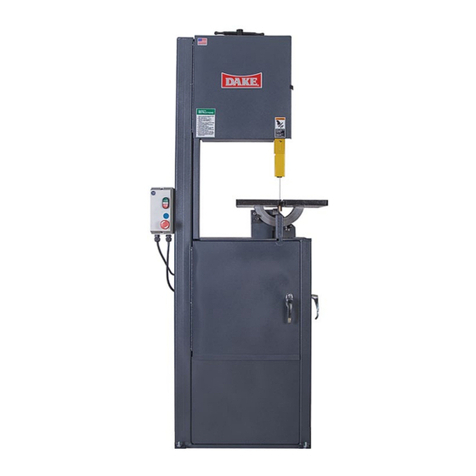
Laguna Tools
Laguna Tools DAKE 14-10 instruction manual
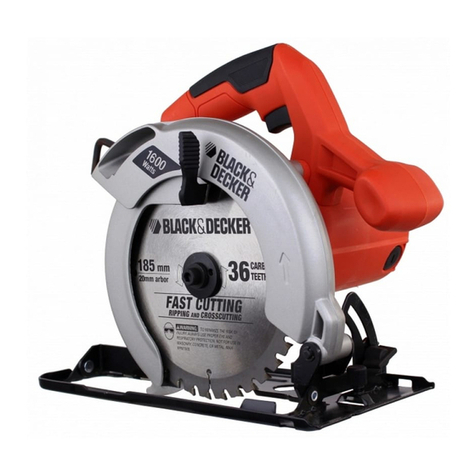
Black & Decker
Black & Decker CS1500-IN manual
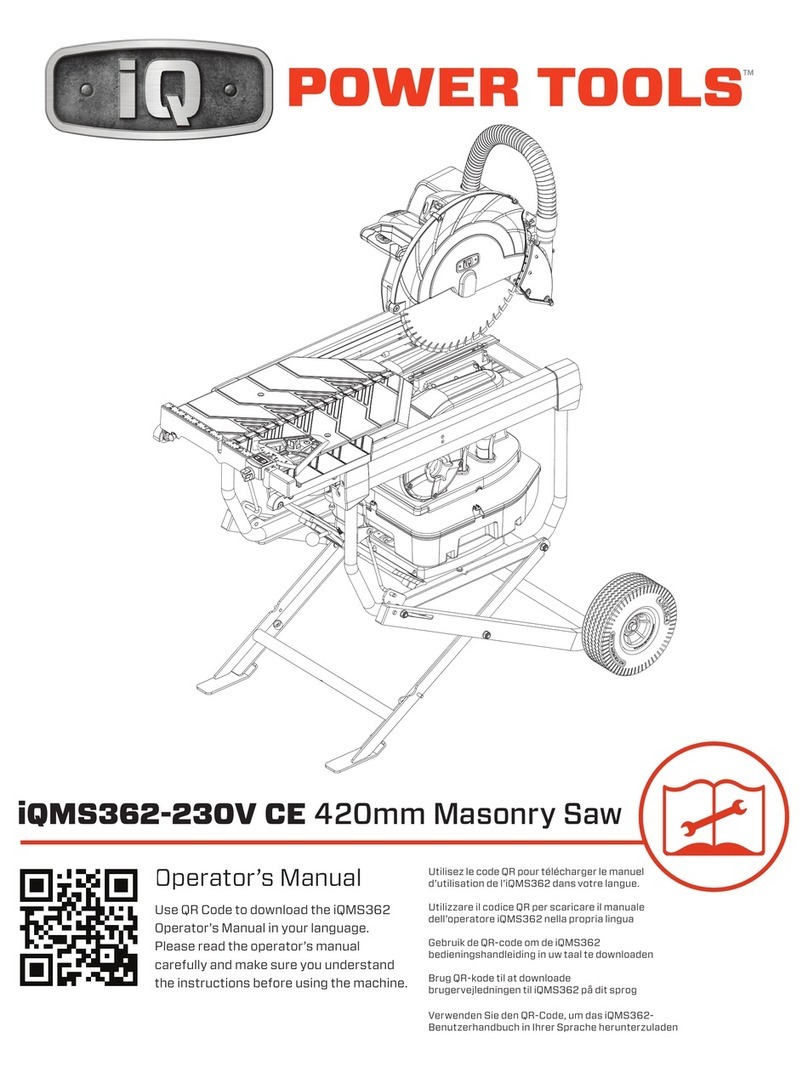
IQ Power Tools
IQ Power Tools iQMS362-230V CE Operator's manual

Inland
Inland DB-100 user guide
